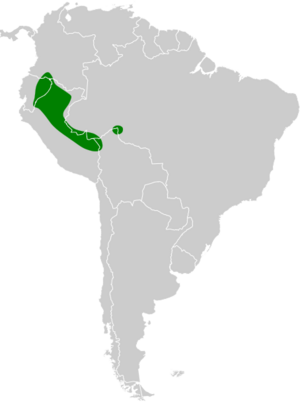Chestnut-headed crake facts for kids
Quick facts for kids Chestnut-headed crake |
|
|---|---|
 |
|
| Conservation status | |
| Scientific classification | |
| Genus: |
Rufirallus
|
| Species: |
castaneiceps
|
 |
|
| Synonyms | |
|
|
The chestnut-headed crake (Rufirallus castaneiceps) is a small, shy bird that lives in the forests of South America. It's part of the Rallidae family, which includes rails, gallinules, and coots. You can find this interesting bird in countries like Bolivia, Brazil, Colombia, Ecuador, and Peru.
Contents
About Its Name and Family
Scientists who study birds sometimes have different ideas about how to group them. For the chestnut-headed crake, some experts place it in a group called Rufirallus with another bird, the russet-crowned crake. Other experts put it in a group called Anurolimnas, which also includes the russet-crowned crake and the black-banded crake. Even though they have different ideas about the main group, everyone agrees that there are two slightly different types, or subspecies, of the chestnut-headed crake. These are called R. c. castaneiceps and R. c. coccineipes.
What Does It Look Like?
The chestnut-headed crake is about 19 to 21.5 cm (7.5 to 8.5 in) long, which is roughly the size of a robin. One female bird weighed about 126 g (4.4 oz), which is lighter than a can of soda. Male and female birds look very similar.
Colors and Features
Adult chestnut-headed crakes have a bill that is mostly black on top. The bottom part of the bill is greenish near the nostrils and black at the tip.
The front of their head, the sides of their head and neck, and their chest are a bright reddish-brown color, called rufous. Their throat can be orange-red or a light creamy color. The top of their head, back, rump, and wing feathers are a brownish-olive color. Their belly and the area under their tail are also brownish-olive. Their legs and feet are usually dull brown or olive-green.
Younger birds are not as brightly colored. Their reddish-brown areas are more of a dull brown or brownish-olive. Their throat is a pale grayish-cream color.
Subspecies Differences
The subspecies called R. c. coccineipes is special because it has red legs and feet! Its feathers look very similar to the other subspecies. Some scientists think it might have greener upper parts or slightly different reddish tones, but others don't see much difference in the feathers.
Where It Lives and What It Likes
The first subspecies, R. c. castaneiceps, lives in southern Colombia, eastern Ecuador, and northern Peru. Its southern border in Peru is near the Rio Napo river.
The second subspecies, R. c. coccineipes, is found from the Rio Napo area in Ecuador and Peru, stretching south into the very northwest of Bolivia. There's also a separate group of these birds in Brazil's Acre state.
Its Home
This bird likes to live in humid places with lots of thick plants and bushes, like secondary forest (forests that have grown back after being cut down). It especially likes old farm plots that have become overgrown in tropical evergreen forests. Unlike many other birds in its family, the chestnut-headed crake can be found far away from water.
In Colombia, you can find it up to 1,500 m (4,900 ft) high in the mountains. In Ecuador, it mostly lives below 700 m (2,300 ft), but it can sometimes be seen as high as 1,000 m (3,300 ft).
How It Behaves
Movement
The chestnut-headed crake stays in the same area all year round. It does not migrate.
Feeding Habits
This bird finds its food by poking around in leaves and rotten wood on the ground. It also uses its bill to flick aside leaves. Sometimes, it stretches up to peck at similar things above the ground. Scientists haven't fully documented what it eats, but they believe it mostly eats small bugs and seeds.
Breeding and Nests
We don't know much about how the chestnut-headed crake raises its young. It seems that their nesting season includes the month of June.
Its Song
The chestnut-headed crake has a loud and musical song. One person described it as a long series of whistles that can last up to five minutes. It sounds like "wee-hoohoo wee-hoohoo wee-hoohoo..." When it's being aggressive, it makes a quiet, sputtering sound.
Its Conservation Status
The IUCN (International Union for Conservation of Nature) has listed the chestnut-headed crake as a species of Least Concern. This means it's not currently in danger of disappearing. However, we don't know exactly how many of these birds there are, and their population is thought to be decreasing.
No immediate threats to the species have been found. It's considered uncommon in most places it lives. Interestingly, it seems to do well with a little bit of human activity, as it can use the edges of small garden plots for its habitat.


